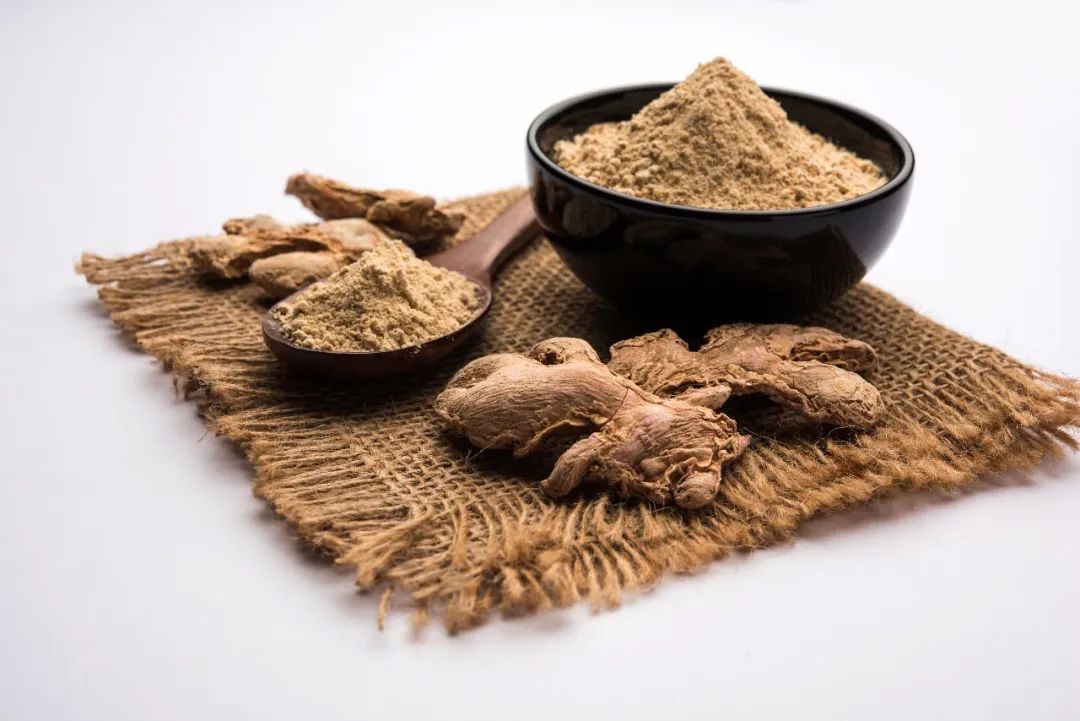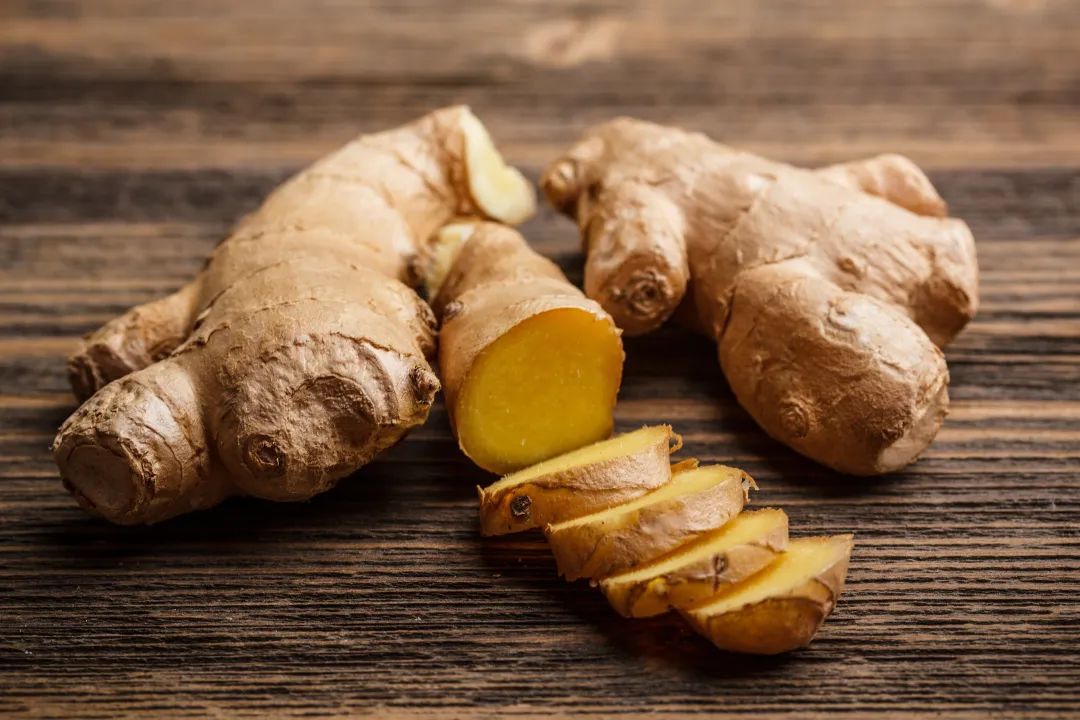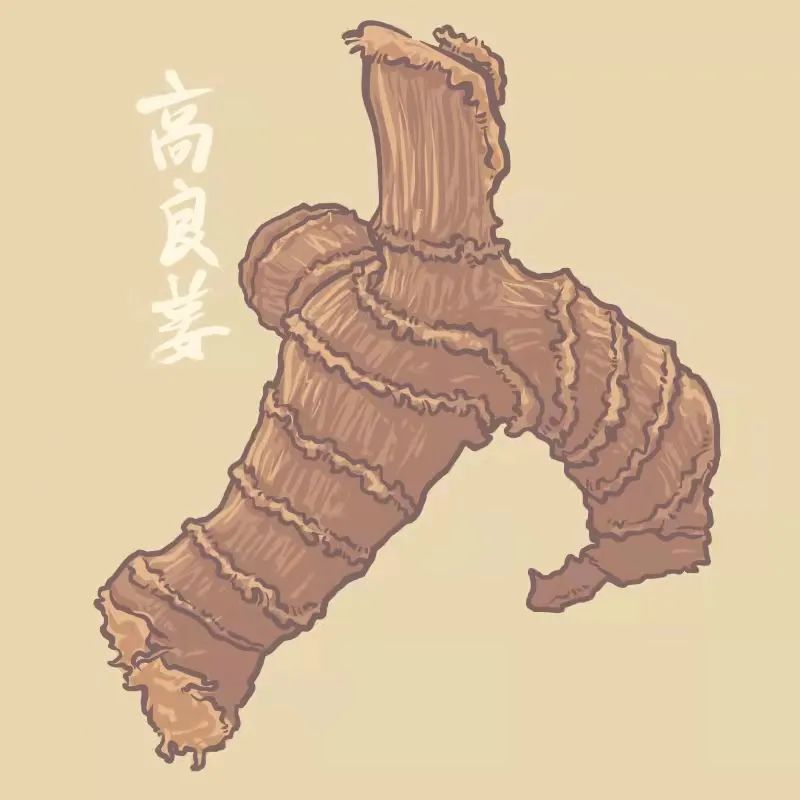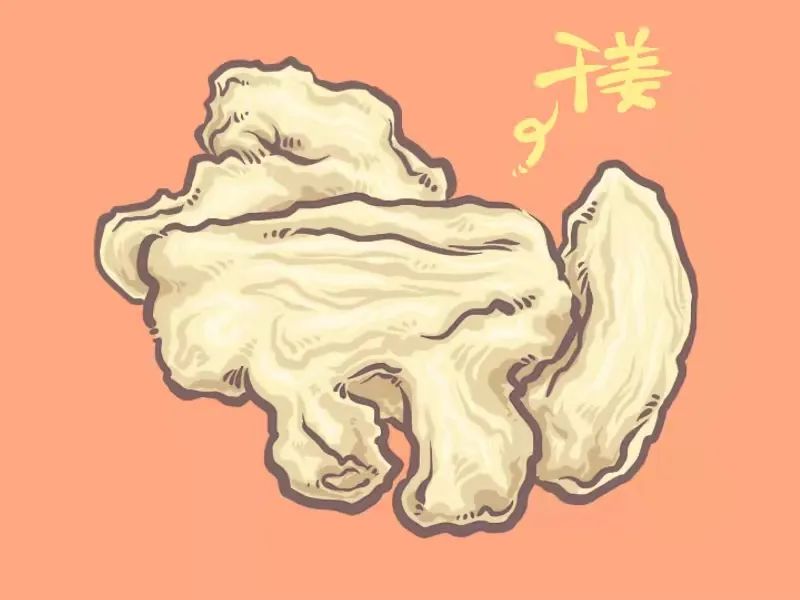
“New Perspectives on Traditional Chinese Medicine” series articles are not purely theoretical knowledge of TCM, but rather interpretations of dietary therapy and medicinal food ingredients from modern scientific and nutritional perspectives, aiming to broaden horizons, expand thinking, and inspire wisdom, providing new perspectives and ideas for understanding the wisdom of ancient people.
Whenever we mention “ginger,” the first thing that often comes to mind is fresh ginger.
In fact, there is another type of “ginger” that has equally remarkable uses in daily life: Galangal (Gao Liang Jiang).
Galangal, also known as Alpinia officinarum, is the dried rhizome of the herbaceous plant in the ginger family, primarily produced in Guangdong, Guangxi, and Hainan. It has the functions of warming the stomach and stopping vomiting, dispersing cold and relieving pain.
Li Shizhen stated that it can strengthen the spleen and stomach, relieve food stagnation, break cold phlegm, and eliminate malaria. In TCM, it is commonly used to regulate excess cold in the middle jiao, abdominal cold pain, stomach cold vomiting, and acid regurgitation.
Today, let’s take a closer look at how galangal works wonders within the body.
Dispersing Cold and Relieving Pain for Stomach Cold Abdominal Pain
In TCM, galangal is known for its ability to warm and disperse cold pathogens in the middle jiao and can also relieve pain, making it suitable for stomach cold and abdominal cold pain, often used in conjunction with roasted ginger.
We all know that the spleen and stomach are the foundation of postnatal life, the source of qi and blood production, where the stomach descends turbid and the spleen ascends clear, serving as the pivot for the body’s qi movement.
When there is deficiency and cold in the spleen and stomach, the qi movement can become disordered, leading to symptoms such as diarrhea, undigested food, and difficulty urinating, which can also result in stomach pain.
Relieving Spasms and Pain
In TCM, it is believed that “cold qi resides between the intestines and stomach, causing blood stagnation and resulting in pain”. Abdominal cold pain is a common clinical symptom.
We can simply imagine that when we feel cold, we instinctively “shiver” and want to curl up to keep warm.
Similarly, when the intestines and stomach feel cold, they also “shiver” and want to curl up to “warm up”.
This can manifest in our bodies as spasms, pain, and other symptoms.

◎Image authorized by Baotu Network
Galangal has scientific means to address this issue.
Researchers established a model of spleen and stomach deficiency and applied galangal to regulate it, finding that the water decoction of galangal can alleviate symptoms such as diarrhea and pain caused by spleen and stomach deficiency.
In vitro experiments showed that the water decoction of galangal, flavonoid components, and diaryl heptane components can regulate spontaneous contraction activity of the ileum, relieving spasms and pain.
How does it achieve this?
On a microscopic level, acetylcholine (Ach) binds to the M receptors on the smooth muscle of the gastrointestinal wall, coupling with G proteins and adenylate cyclase, reducing intracellular cyclic adenosine monophosphate (cAMP) levels, which leads to an increase in intracellular calcium ions, causing smooth muscle contraction. Barium ions from barium chloride enter the cells and bind with calmodulin, causing intestinal smooth muscle to contract strongly.
Free calcium ions are usually obtained from the influx of extracellular calcium ions and the release of intracellular calcium ions. In a calcium-free solution, the first phase of smooth muscle contraction induced by Ach mainly relies on the release of intracellular calcium, while the second phase of contraction is primarily due to Ach promoting the influx of extracellular calcium ions through voltage-operated calcium channels.
The water decoction of galangal, flavonoid components, and diaryl heptane components have inhibitory effects on Ach and barium chloride-induced intestinal contractions in vitro, indicating that the spasmolytic ability of galangal on the gastrointestinal tract may be related to its calcium antagonistic properties.
Anti-Ulcer
For individuals with gastric ulcers, galangal is also very beneficial.
Researchers explored the mechanism by which galangal regulates gastric ulcers. Experiments showed that the volatile oil of galangal can reduce the gastric ulcer index and enhance the level of ulcer inhibition. The volatile oil of galangal can inhibit the gastric juice volume, total acidity, and pepsin activity induced by reserpine in gastric ulcer models, and can increase serum nitric oxide levels and superoxide dismutase activity while reducing malondialdehyde levels. The anti-ulcer ability of galangal’s volatile oil may be related to its acid-inhibiting, antioxidant, vasodilatory, and protective factor-enhancing properties.

◎Image authorized by Baotu Network
Additionally, the anti-ulcer properties of galangal’s volatile oil may also be related to its ability to increase serum somatostatin and vasoactive intestinal peptide levels while decreasing levels of gastrin and substance P.
Other studies have found that the volatile oil of galangal can increase serum nitric oxide levels, expand blood vessel walls, improve gastric mucosal microcirculation, and scavenge oxygen free radicals, thereby protecting the normal function of the gastric mucosa.
When using galangal to regulate stomach cold qi stagnation, liver qi invading the stomach, and abdominal distension and pain, it is often used in combination with Xiang Fu (Cyperus rotundus) to soothe the liver, relieve depression, disperse cold, and relieve pain.
Warming the Middle and Stopping Vomiting for Stomach Cold Vomiting
In TCM, galangal is believed to both warm the middle and disperse cold, and can also stop vomiting.
Stomach cold can also lead to a symptom of vomiting.
Let’s take a closer look at how vomiting occurs on a microscopic level.
Initially, the vomiting reflex is a protective reflex of the body.
As we know, humans have evolved gradually, and our bodies are constantly adapting to the environment.
When harmful substances are accidentally ingested, our bodies instinctively want to expel these “bad things”.
This is a form of self-protection.
Certain substances can stimulate the gastrointestinal tract, causing specific cells in the gastrointestinal tract to secrete various chemical transmitters such as serotonin, muscarine, dopamine, and substance P, which affect corresponding receptors, transmit signals through the vagus nerve to the vomiting center, or directly enter the central nervous system’s chemoreceptor trigger zone via the bloodstream, triggering the vomiting reflex through efferent fibers via the vagus, sympathetic, phrenic nerves, and spinal nerves that innervate the throat.
However, as you can see, the vomiting response involves many steps, and with so many processes, some steps are bound to encounter issues.
As a result, vomiting can be triggered not only by “eating the wrong thing” but also by stimulating any step or several steps in the process.
In modern clinical practice, receptor antagonists are often used to stop vomiting. However, if there are no specific pathological changes or medication indications, vomiting in daily life, such as that caused by stomach cold, is often the body’s way of self-regulating.
Galangal can assist the body in this regulation to a certain extent.

◎Image authorized by Baotu Network
Researchers have observed the effects of galangal on stomach cold vomiting through scientific experiments, showing that galangal helps alleviate vomiting-related symptoms, can extend the latency period of vomiting, delay the onset of vomiting, and reduce the frequency of vomiting.
The mechanism may be related to the spasmolytic ability of galangal flavonoids, which can inhibit Ach-induced smooth muscle tension increase, thereby warming the middle and stopping vomiting.
When using galangal to regulate stomach cold vomiting, it is often combined with Ban Xia (Pinellia ternata) and Sheng Jiang (Fresh Ginger) to warm the middle and stop vomiting; if regulating deficiency cold vomiting, it is often used with qi-tonifying and spleen-strengthening herbs.
Galangal vs. Dried Ginger
Many people often ask about the difference between galangal and dried ginger. Today, let’s understand this together.
Although galangal and dried ginger both belong to the ginger family, they are different plants with significant differences in appearance.
Galangal is the dried rhizome of the plant Alpinia officinarum.

△Galangal ◎Image authorized by Baotu Network
Dried ginger is the dried rhizome of the plant Zingiber officinale.

△Dried Ginger ◎Image authorized by Baotu Network
This “dried ginger” is not simply fresh ginger that has been dried; it is the “mother ginger” that is dried.
“Mother ginger” refers to the old ginger harvested in the spring, which sprouts underground and grows new rhizomes. The newly grown rhizomes are called “fresh ginger.”
Fresh ginger has a stronger dispersing property and is less pungent than dried ginger.

△Fresh Ginger ◎Image authorized by Baotu Network
So, are there differences in their abilities?
Although both galangal and dried ginger have pain-relieving, antiemetic, and warming properties, there are certain differences in their details.
Galangal is more focused on warming the interior and is suitable for regulating various symptoms caused by stomach cold, such as stomach cold pain, cold qi stagnation, and vomiting.

◎Illustration by an 8-year-old
Dried ginger tends to focus on tonifying yang, capable of warming the middle, dispersing cold, warming the lungs, transforming phlegm, and reviving yang and unblocking meridians, suitable for individuals with cold phlegm cough, abdominal cold pain, cold limbs, and vomiting.

◎Illustration by an 8-year-old
Of course, when treating diseases, they are often used in combination.
Consumption of Galangal
Using galangal is quite simple. It can be made into tea, decoction, porridge, or infused in alcohol… there are countless methods, and there is always one that is easy to follow.
☼ Galangal Porridge
Take 3-6 grams of galangal, about 50 grams of japonica rice, and an appropriate amount of white sugar.
Wash the galangal, decoct it in water to extract the juice, then add the japonica rice to cook into porridge. When boiling, add an appropriate amount of white sugar, and cook until the porridge is done. It can be consumed once or twice a day for 3-5 consecutive days.
This porridge warm the spleen and stomach, disperse cold and relieve pain, suitable for spleen and stomach deficiency cold, abdominal cold pain, nausea and vomiting, vomiting clear water, and alcohol-induced vomiting.
☼ Galangal Tea
Take 3-6 grams of galangal and an appropriate amount of brown sugar.
Decoct the galangal in water, then add the appropriate amount of brown sugar to drink.
For those with post-alcohol vomiting and discomfort, drinking a warm cup of galangal tea is a good way to relieve symptoms, helping to protect the gastric mucosa, reduce alcohol irritation, and improve symptoms of vomiting and gastric discomfort.
☼ Galangal and Red Date Drink
Take 3-6 grams of galangal, 5-8 red dates, and an appropriate amount of brown sugar.
Place the split red dates and galangal in a clay pot, soak in an appropriate amount of water, and simmer for about 30 minutes. Strain the liquid and add brown sugar to mix well. Take one dose daily, divided into two servings.
This drink helps to warm the stomach, stop vomiting, tonify the spleen, and nourish blood. It is beneficial for regulating symptoms caused by stomach cold, such as abdominal cold pain, acid reflux, belching, and indigestion.
It is important to note that those with yin deficiency and heat should use galangal cautiously. It should be avoided in cases of vomiting due to stomach heat, summer heat dysentery, damp-heat diarrhea, chest pain due to qi deficiency, and during pregnancy.

◎Image authorized by Baotu Network
Recently, I saw a saying online: “If one day you feel empty inside, eat something, because filling the stomach will fill the heart too.”
Food always has this unique charm, as if having beloved food nearby can make all desolation and difficulties fade away, swallowed into the belly, and life continues to shine with hope.
Just like this small galangal, it not only warms our stomach but has also warmed many difficult times.
May our lives be warm and smooth, filled with joy year after year.
[References]
1. Liang Xiaohui, Yu Mingzhu, Shi Hailian, etc. Galangin inhibits NF-κB pathway and promotes autophagy in gastric cancer MGC803 cells. Chinese Journal of Traditional Chinese Medicine, 2021.
2. Gui Bei, Gao Zhenhu, Jia Zhen, etc. A comparative study on gastrointestinal spasmodic and analgesic effects of different parts of Alpinia officinarum Hance. New Chinese Medicine and Clinical Pharmacology, 2021.
3. Reversing β-lactam antibiotic resistance of Staphylococcus aureus with galangin from Alpinia officinarum Hance and synergism with ceftazidime. Phytomedicine, 2010.
4. Lu Hao, Chen Xiwen, Yaohui, etc. Pharmacological effects and cellular mechanisms of galangin in preventing and treating uric acid kidney injury. Central South Pharmacy, 2020.
5. Li Xiangyi, Dong Guangchuan, Yang Dan, etc. Research progress of Alpinia officinarum Hance volatile oil. Chemical Management, 2020.
6. Galangin attenuates mast cell-mediated allergic inflammation. Food and Chemical Toxicology, 2013.
7. Ma Xiaoqing. Screening and mechanism of anti-gastritis active parts of Alpinia officinarum Hance. 2019.
8. Genaguli Hayrigo. Study on the anti-gastric cancer effect and mechanism of Alpinia officinarum Hance. 2019.
9. Galangin-induced down-regulation of BACE1 by epigenetic mechanisms in SH-SY5Y cells. Neuroscience, 2015.
10. Xiong Yuanguo, Shen Yao, Zhang Hong. New progress in the study of pharmacological activity of Alpinia officinarum Hance. Zhongnan Pharmacy, 2017.
11. Zeng Yongchang, Liang Shaoyu, Wu Junhong, etc. A network pharmacology study on the regulation of diseases by medicinal and edible Alpinia officinarum Hance. 2017.
12. Antifibrotic activity of galangin, a novel function evaluated in animal liver fibrosis model. Environmental Toxicology and Pharmacology, 2013.
13. Ma Xiaoni. Study on the chemical constituents of Alpinia officinarum Hance and its anticancer activity. 2016.
14. Cheng Yuan, Li Jin, Liao Xiaodan, etc. Effects of different active parts of Alpinia officinarum Hance on isolated rabbit intestinal smooth muscle. 2015.
15. Galangin induces apoptosis in gastric cancer cells via regulation of ubiquitin carboxy-terminal hydrolase isozyme L1 and glutathione S-transferase P. Food and Chemical Toxicology, 2011.
16. Wei Na. Study on the pharmacological effects of Alpinia officinarum Hance on gastric ulcer and its pharmacodynamic material basis. 2015.
17. Li Hongfu, Li Yonghui, Wang Yong, etc. Study on the chemical constituents and pharmacological activities of Alpinia officinarum Hance. Chinese Journal of Experimental Formulas, 2014.
18. Liang Wannian, Jiang Tao, Tang Chunping, etc. Effects of total flavonoids of Alpinia officinarum Hance on irritable bowel syndrome with deficiency of spleen and stomach. Chinese Patent Medicine, 2013.
19. Yan Bo, Bai Xiaolu, Hu Jingyi and so on. Antipyretic and anti-inflammatory effects of Alpinia officinarum Hance. Traditional Chinese Medicine Pharmacology and Clinical, 2013.
20. Phenylpropanoids of Alpinia galanga as efflux pump inhibitors in Mycobacterium smegmatis mc 2 155. Fitoterapia, 2012.
21. Han Jian. Analgesic effects of Alpinia officinarum Hance and its effects on intestinal motility. China Pharmaceutical, 2012.
22. Wang Haiyan, Liu Yaming, Li Haiyan, etc. Effects of Alpinia officinarum Hance oil on serum motilin, somatostatin, substance P and vasoactive intestinal peptide in gastric ulcer mouse model. Chinese Journal of Experimental Formulas, 2011.
23. Zhu Jiaxiao, He Wei, Ma Jianchun. Research progress of Alpinia officinarum Hance. Food and Drugs, 2009.
24. Dietary compounds galangin and myricetin suppress ovarian cancer cell angiogenesis. Journal of Functional Foods, 2015.
25. Yang Yanjun, Sha Congwei, Chen Xiaojuan, etc. Analgesic study of the active site of Alpinia officinarum Hance. 2008.
26. Tang Chunping, Jiang Tao, Chen Shaoyi, etc. Effects of total flavonoids of Alpinia officinarum Hance on the motility of isolated ileum in rabbits. Traditional Chinese Medicine Pharmacology and Clinical, 2006.
27. Li Fang. The preventive effect of galangin in Alpinia officinarum Hance on experimental gastric ulcer in animals. 2006.
28. Lu Wei, Jiang Linghuo. Chemical constituents and pharmacological effects of Alpinia officinarum Hance. China Pharmaceutical, 2006.
29. Chen Dian, He Rui, Li Caijun. Study on active ingredients of Alpinia officinarum Hance analgesia and antiemetic. 2001.
30. Zhang Mingfa, Shen Yaqin. Wenli Pharmacological Study of Alpinia officinarum Hance. 1996.
31. Zhang Mingfa, Duan Jingyun, Chen Guangjuan, etc. Pharmacological study on Alpinia officinarum Hance warming meridian and relieving pain. 1992.
32. Zhu Ziping, Chen Guangjuan, Zhang Mingfa, etc. Pharmacological study on warm and moderate pain relief of Alpinia officinarum Hance. Chinese Herbal Medicine, 1991.
Classic knowledge passed down with care, experience validated by the “new”. This is the New Perspectives on Traditional Chinese Medicine column, bringing you from life into science, from TCM to the world. If you would like to learn more about other medicinal and culinary ingredients, feel free to leave us a message!
— THE END —
Related Articles Review
☼Can soybeans be used as medicine? You might often eat them!
☼Do leeks and leek seeds really have aphrodisiac effects?
☼Let’s talk about seasonings that can resolve dampness, promote qi, and warm the middle to stop vomiting~
For more related articles, please search within the public account.
☼Article Search Guide
❀Article by Yi Ru
❀Editor: Yi Ru
❀Proofreader: Zi Ye
❀All images in the article are credited; please do not use without authorization.


Prize-Winning Essay Collection
If you also have a story related to TCM, you can write it down and submit it to us at any time. Please send your article in Word format to our email.
Please ensure that the submitted article is original and include your WeChat nickname, name, phone number, address, and other contact information. After selection, we will obtain authorization from the author to publish it in our channel, and once published, we will send you a signed book by Dr. Luo!
Thank you for your active feedback, and we look forward to you sharing your story with TCM with us and more people, allowing more to feel the charm of Chinese culture.

Dr. Luo’s official WeChat public account has the following four, please scan the QR code to follow. Any others are imitations, please do not be deceived!

Dr. Luo’s Channel
WeChat ID: luodalunpd
Dalun Academy
WeChat ID: Dalun_sy


Dalun Parenting Talk
WeChat ID: dalun_yes
Dr. Luo Dalun
WeChat ID: Drluodalun

🔹The copyright of original articles in this public account belongs to this account. If you need to reprint, please leave a message to the editor and indicate the source. Commercial use is prohibited.
🔹The articles reprinted by this public account are for learning and communication purposes only and fall within the scope of fair use. If there are errors in the attribution of images, data sources, or text copyright, please inform the editor, and corrections or deletions will be made immediately.
🔹This public account holds the portrait rights of Dr. Luo Dalun. Unauthorized use will be pursued legally.
🔹This public account is legally supported by Beijing Zhongzhe (Shenyang) Law Firm, and will pursue legal responsibility for any unauthorized reprints, commercial use, and refusal to delete posts after warnings.

